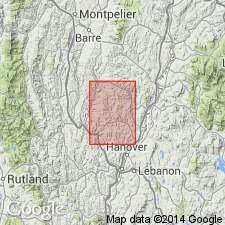
- Usage in publication:
-
- Gile Mountain schists
- Modifications:
-
- Original reference
- Dominant lithology:
-
- Schist
- AAPG geologic province:
-
- New England province
Summary:
Pg. 18-19, pls. 3, 4. Gile Mountain schists. Light- to dark-gray chiefly quartz-mica schists. Less abundant are thin beds of massive and sheared quartzite, occasional coarse feldspathic schists, calcareous beds, and some graphic layers. Becomes more highly metamorphosed toward western part of outcrop belt where predominantly coarse amphibolites are prevalent. Thickness (excluding Meetinghouse slates) estimated about 6,500 feet. Meetinghouse slates, which are gradational westward into the schists, are the upper member of unit. Age is Early Devonian.
Source: US geologic names lexicon (USGS Bull. 1200, p. 1506-1507).
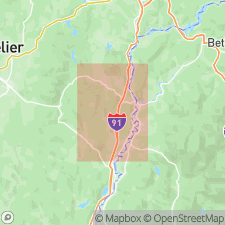
- Usage in publication:
-
- Gile Mountain formation
- Modifications:
-
- Age modified
- Areal extent
- Dominant lithology:
-
- Schist
- AAPG geologic province:
-
- New England province
Summary:
Pg. 654-656, 662, pl. 1 (geol. map). Gile Mountain formation. Thinly to thickly interbedded dark-gray to black schist (phyllite near eastern border of outcrop area) and light-gray micaceous quartzite, either which may be locally dominant. Thickness probably 6,000 to 7,000 feet. In gradational contact with Waits River formation to west and Meetinghouse slate to east. Includes rocks at type locality and most of rocks mapped by Doll as "Gile Mountain Schist[s]" in Strafford quadrangle. It does not, however, include any rocks exposed in southeast corner of Strafford quadrangle east of Ammonoosuc thrust that Doll mapped as Gile Mountain; these rocks are areally continuous along their strike with Oxfordville formation of the Mt. Cube quadrangle. Tentatively assigned to Middle Ordovician.
Source: Publication; US geologic names lexicon (USGS Bull. 1200, p. 1506-1507).

- Usage in publication:
-
- Gile Mountain Formation*
- Modifications:
-
- Overview
- AAPG geologic province:
-
- New England province
Summary:
Used as Gile Mountain Formation of Early Devonian age. Consists of gray, slightly rusty, poorly bedded phyllite and schist containing 20 cm to 20 m beds of light-gray, fine-grained quartzite, local punky-brown-weathering calcareous granofels or quartzose marble, and pods and stringers of vein quartz. Unnamed quartzite-rich unit and amphibolite and hornblende schist unit separately mapped.
Source: GNU records (USGS DDS-6; Reston GNULEX).
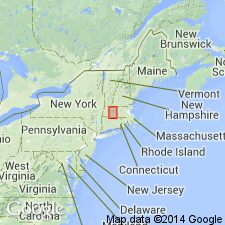
- Usage in publication:
-
- Gile Mountain Formation*
- Modifications:
-
- Revised
- AAPG geologic province:
-
- New England province
Summary:
Rocks mapped as Conway Schist by Emerson (1898, 1917) and subsequently subdivided by Segerstrom (1956) and Willard (1956) were mapped across the MA-VT State line as Waits River and Gile Mountain Formations by Doll and others (1961) on Centennial Geologic Map of Vermont. Although controversy still exists over relative ages, detailed reconnaissance mapping by authors and S.F. Clark, Jr., L.M. Hall, and J.W. Pferd shows that Waits River and Gile Mountain Formations are readily distinguished in the field. For these reasons, and to maintain continuity across the State line, authors chose to follow VT nomenclature here and on MA State bedrock geologic map (Zen and others, 1983). Primary difference between Waits River and Gile Mountain is presence in Gile Mountain of beds of noncalcareous, commonly micaceous quartzite. Both formations contain conspicuous beds of punky brown-weathering impure marble or calcareous granulite, mostly in Waits River and less abundant in Gile Mountain. Predominant lithology of both formations is typically contorted gray, graphitic, locally very sulfidic, moderately aluminous mica schist containing quartz veins. Gradational but definitely significant boundary can be mapped between both formations. Amphibolite in both formations may correlate with Standing Pond Volcanics occurring at or near Waits River-Gile Mountain contact in VT. Report goes into great detail regarding informal subdivision of each formation.
Source: GNU records (USGS DDS-6; Reston GNULEX).
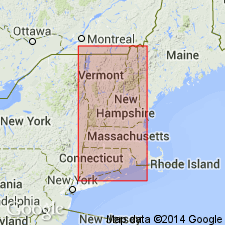
- Usage in publication:
-
- Gile Mountain Formation*
- Modifications:
-
- Revised
- AAPG geologic province:
-
- New England province
Summary:
A unit of dark-gray, carbonaceous phyllite interbedded with minor thin (up to 15 cm) beds of punky-brown-weathering granulite and local thin, graded quartzite beds, which forms a narrow (0.5 to 1 km) unit along the west margin of the Connecticut Valley trough in east-central and northeastern VT, mapped as the Northfield Formation, has long been considered the basal unit of a synclinorium, underlying the Waits River Formation and equivalent to the Meetinghouse Slate on the east margin of the trough. It is here reinterpreted as a distal facies of the Gile Mountain Formation which is at the top of the Connecticut Valley trough sequence, here interpreted as a fault-bounded anticlinorium. The Meetinghouse Slate (Member of the Gile Mountain Formation of Doll and others (1961) is also here interpreted as lying at the top of the sequence. Age is Early Devonian.
Source: GNU records (USGS DDS-6; Reston GNULEX).
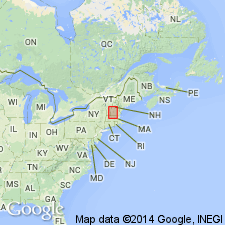
- Usage in publication:
-
- Gile Mountain Formation
- Modifications:
-
- Geochronologic dating
- AAPG geologic province:
-
- New England province
Summary:
Isochron age of 425+/-5 Ma determined for Gile Mountain Formation. Isochron cooling age of 440+/-1 Ma determined for Standing Pond Volcanics. U-Pb of 423 Ma found for felsic dike that cuts Standing Pond near Springfield, VT. Data presented support occurrence of amphibolite facies metamorphic event in eastern VT and central MA during the Ordovician. All rocks of the CT Valley synclinorium (Gile Mountain, Waits River, and underlying strata) were subjected to this same event.
Source: GNU records (USGS DDS-6; Reston GNULEX).
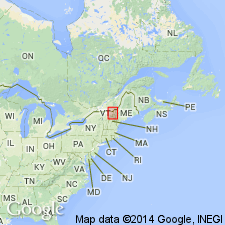
- Usage in publication:
-
- Gile Mountain Formation*
- Modifications:
-
- Biostratigraphic dating
- AAPG geologic province:
-
- New England province
Summary:
Presence of plant fossils in northern NH and southern Quebec supports a late Early Devonian (Emsian) age for the Gile Mountain Formation and its equivalent, the Compton Formation. Gile Mountain includes the (ascending) Meetinghouse Slate Member and the Northfield Member. Authors conclude that the rocks of the Connecticut Valley trough accumulated continuously beginning as early as the Silurian and extending into the latest Early Devonian.
Source: GNU records (USGS DDS-6; Reston GNULEX).
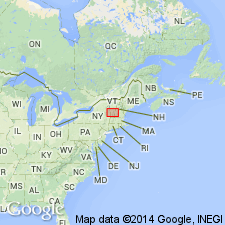
- Usage in publication:
-
- Gile Mountain Formation*
- Modifications:
-
- Areal extent
- AAPG geologic province:
-
- New England province
Summary:
Rocks of Connecticut Valley-Gaspe terrane occupy broad area in eastern half of Glens Falls quad. Includes Northfield, Waits River, and Gile Mountain Formations. To the west are [unspecified] phyllites or schists; quartzose, micaceous carbonate rocks; conglomerate, limestone; and metavolcanic rocks (Shaw Mountain Formation). To the east, metamorphosed calcareous shale of Waits River Formation becomes less abundant and gives way to interbedded schists and quartzite of Gile Mountain Formation. Unnamed conglomerate also found near eastern margin. Standing Pond Volcanics is a central marker unit containing pillow lavas, tuffs, and rocks of mixed (sedimentary or volcaniclastic origin). Sparse fossils have dated these rocks as Middle or Late Ordovician, Silurian, or Devonian (Currier and Jahns, 1941; Cady, 1950; Doll, 1984; Hueber and others, 1990).
Source: GNU records (USGS DDS-6; Reston GNULEX).
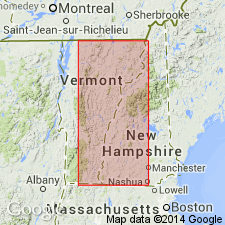
- Usage in publication:
-
- Gile Mountain Formation*
- Modifications:
-
- Revised
- AAPG geologic province:
-
- New England province
Summary:
Structural studies in northeastern and east-central VT show that the belt long known as the Connecticut Valley synclinorium is a faulted anticline, and it is here renamed the Connecticut Valley trough. The Waits River Formation underlies the Gile Mountain Formation. The Northfield Formation and Meetinghouse Slate Member of the Gile Mountain Formation were interpreted as resting depositionally on older rocks to the west and east. The Northfield is revised as the Northfield Member of the Gile Mountain Formation, at the top of the Gile Mountain, rather than a separate formation below the Gile Mountain-Waits River package. The Meetinghouse Slate (Member of the Gile Mountain Formation of Doll and others (1961)) is revised as the Meetinghouse Slate Member of the Gile Mountain Formation, but at the top rather than at the bottom of the formation. The Standing Pond Volcanics (Standing Pond Volcanic Member of the Waits River Formation of Doll and others (1961)) is retained as the Standing Pond Volcanic Member of the Waits River. Age of all the trough rocks, including the Northfield, remains Early Devonian.
Source: GNU records (USGS DDS-6; Reston GNULEX).
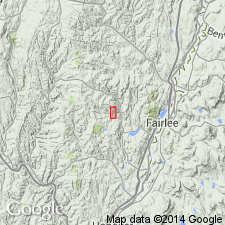
- Usage in publication:
-
- Gile Mountain Formation*
- Modifications:
-
- Age modified
- AAPG geologic province:
-
- New England province
Summary:
Authors disagree with Hatch (1991) regarding age of Gile Mountain Formation, Waits River Formation, and Standing Pond Volcanic Member of Waits River Formation. The Standing Pond Volcanic Member occurs mostly along mapped Gile Mountain-Waits River contact. 70 km south of Ely, VT, a felsic dike dated as Middle Silurian by Aleinikoff and Karabinos (1990) intrudes the Standing Pond; this effectively dates the Waits River Formation as no younger than Middle Silurian. The overlying Gile Mountain Formation is tentatively assigned a Middle Silurian(?) to Early Devonian age. The Early Devonian part of its age is based on plant fossils in equivalent rocks 100 km to the north in Quebec, as reported by Hueber and others (1990).
Source: GNU records (USGS DDS-6; Reston GNULEX).
- Usage in publication:
-
- Gile Mountain Formation
- Modifications:
-
- Age modified
- AAPG geologic province:
-
- New England province
GNU Staff, 1995, GNU Staff remark by E.D. Koozmin. Standing Pond Volcanics and Gile Mountain Formation in Vermont.: U.S. Geological Survey Digital Data Series, DDS-6, 1 CD-ROM., release 3
Summary:
According to Robert Moench (1993, written commun.) age of Standing Pond Volcanics should be Silurian. Hatch (1991) apparently did not acknowledge U-Pb zircon date of 423+/-4 Ma (Aleinikoff and Karabinos, 1990) from a dike that cuts Standing Pond Volcanics, which therefore must be Silurian (Wenlockian or Llandoverian). It is very likely that unconformably overlying Gile Mountain Formation is also Silurian. Moreover, latest version of Sherbrooke-Lewiston quad shows Gile Mountain Formation (with sparse nondiagnostic fossils) and Compton Formation (with diagnostic Emsian fossils) are not coextensive across international border. Moench suggests retaining Early Devonian age for Gile Mountain Formation, but with a query to flag the problem. Moench also suggests a Silurian age for Waits River Formation as shown in figure 2 of Hatch (1991).
Source: GNU records (USGS DDS-6; Reston GNULEX).

- Usage in publication:
-
- Gile Mountain Formation*
- Modifications:
-
- Age modified
- Overview
- AAPG geologic province:
-
- New England province
Summary:
Previously considered to be Early Devonian based on Emsian plant fossils from Compton Formation of QUE (Hueber and others, 1990; Hatch, 1991). Age assignment here changed to Early Devonian(?) because recent mapping indicates that Gile Mountain and Compton are not coextensive across VT-QUE border as formerly believed by Doll and others (1961, State map) and St. Julien and Slivitsky (1987). Instead, the formations are separated by Ironbound Mountain Formation. Ironbound Mountain Formation is conformably overlain by Compton, but it is not yet known whether Ironbound Mountain is overlain or underlain by Gile Mountain; this is shown by queried Ironbound Mountain-Gile Mountain contact in area of Averill 7.5-min quad, VT. Correlation of Gile Mountain and Compton is justified only if Gile Mountain in this area conclusively is shown to be underlain by Ironbound Mountain; otherwise, Gile Mountain (with possible exception of its Meetinghouse Slate Member) would be coeval with Silurian Frontenac Formation. Gile Mountain is mapped undivided in places. In other places, divided into Meetinghouse Slate Member with its volcanic facies, and an unnamed volcanic and sedimentary member. Hatch (1988) proposed that Meetinghouse represents upper part of Gile Mountain on basis of graded bedding seen south of map area. This relationship is not proven, however, because Gile Mountain-Meetinghouse contact is difficult to define and graded beds are not always easily interpreted. On this map, Meetinghouse is tentatively shown to occur below main body of Gile Mountain on basis of remarkable similarity between it and Ironbound Mountain Formation. This relationship easily explains highly pelitic character of the Meetinghouse with upward-coarsening character of Lower Devonian sequences elsewhere in map area.
Source: GNU records (USGS DDS-6; Reston GNULEX).
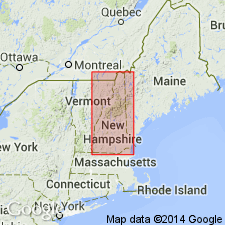
- Usage in publication:
-
- Gile Mountain Formation*
- Modifications:
-
- Overview
- AAPG geologic province:
-
- New England province
Summary:
Used as Early Devonian Gile Mountain Formation. Generally consists of gray to tan metawacke and schist or phyllite, gradational into its Meetinghouse Slate Member, but much more thickly bedded and less pelitic. Contains minor metavolcanic lentils. Unnamed metavolcanic member is possibly equivalent to Putney Volcanics of southeastern VT. Separately mapped interbedded gray slate or phyllite and brown-weathering calcite-ankerite metasiltstone, and minor marble and quartzite, resembles Waits River Formation of VT. Meetinghouse Slate Member consists of gray to black phyllite and silty metasandstone turbidite. Report includes geologic map, cross sections, correlation chart, and four 1:500,000-scale derivative maps.
Source: GNU records (USGS DDS-6; Reston GNULEX).
For more information, please contact Nancy Stamm, Geologic Names Committee Secretary.
Asterisk (*) indicates published by U.S. Geological Survey authors.
"No current usage" (†) implies that a name has been abandoned or has fallen into disuse. Former usage and, if known, replacement name given in parentheses ( ).
Slash (/) indicates name conflicts with nomenclatural guidelines (CSN, 1933; ACSN, 1961, 1970; NACSN, 1983, 2005, 2021). May be explained within brackets ([ ]).

